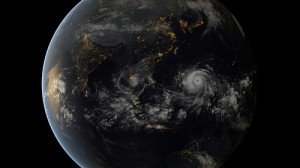Aftermath of Typhoon Haiyan
Reb Anderson
|November 14, 2013

Following in the wake of Super Typhoon Haiyan is the question: Was this storm fueled by climate change?
My answer to these types of questions is always the same: It’s not a question of if it was caused by climate change, it’s a question of how much.
But in this case, however, the “how much” appears to be on the low end. In one very concrete way, climate change did play a role: sea level rise. Any storm can ride in on top of that higher sea level and cause more damage.
Beyond this, though, it starts to get complicated. Hurricanes (and typhoons, the Pacific equivalent of a hurricane) are notoriously difficult to connect to climate change.
Hurricanes and typhoons feed off of warm ocean water and the Pacific was exceptionally warm leading up to Haiyan – Check out this map from NOAA of available heat in the upper ocean in the Pacific. Purple is an exceptionally warm region, but any colored region has available heat to fuel the storm. There’s no doubt this warm pool helped fuel Haiyan with moisture as it headed toward the Philippines.
Warmer air can also hold more moisture – about 4% more water vapor is now in the atmosphere compared to 1970. This also allows storms to get bigger.
It’s these factors of a warmer ocean and a warmer atmosphere that make scientists predict that in the future, we’ll have more of the biggest hurricanes and typhoons like Haiyan. But if we’re already seeing that trend happening and whether Haiyan is part of that trend is far less certain. The recent IPCC report back-stepped a bit on whether we’d already seen evidence of bigger hurricanes. This season, for example, there was an unusual lack of hurricanes in the Atlantic, but an abundance of typhoons in the Pacific. Why? Scientists are still puzzling over that one.
Still, to those living in the Philippines who felt the full force of this devastating storm, sitting back and awaiting a future filled with more Haiyan-style super-typhoons is not an inviting prospect. That is why, at the annual U.N. climate negotiations that opened on Monday in Warsaw, the representative from the Philippines, Yeb Sano, demanded action.
“We refuse, as a nation, to accept a future where super typhoons like Haiyan become a fact of life,” said Sano. Sano has announced that he will fast for the duration of the climate talks or until a meaningful negotiation has been reached. Prior to this announcement, expectations were low for any significant progress at Warsaw. Perhaps this is the wake-up call they need.
Join our Youth Action Network
More Blog Posts

Our Climate Wins Were on Display at the State of the Union
Today, the Biden Administration temporarily halted all pending decisions on 17 Liquefied “Natural” Gas (LNG) projects across the Gulf South.
Read More
ACE Honored As An Anthem Awards Finalist
Action for the Climate Emergency (ACE) announced today that it won Bronze in Best Use of AI at the 3rd …
Read More
BREAKING: Biden Halts LNG Export Expansion
Today, the Biden Administration temporarily halted all pending decisions on 17 Liquefied “Natural” Gas (LNG) projects across the Gulf South.
Read More